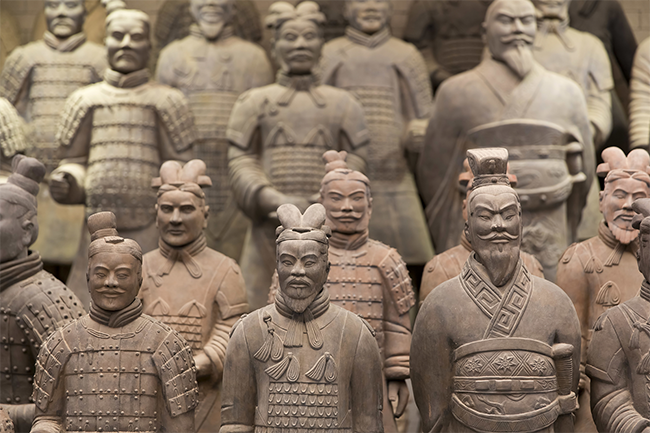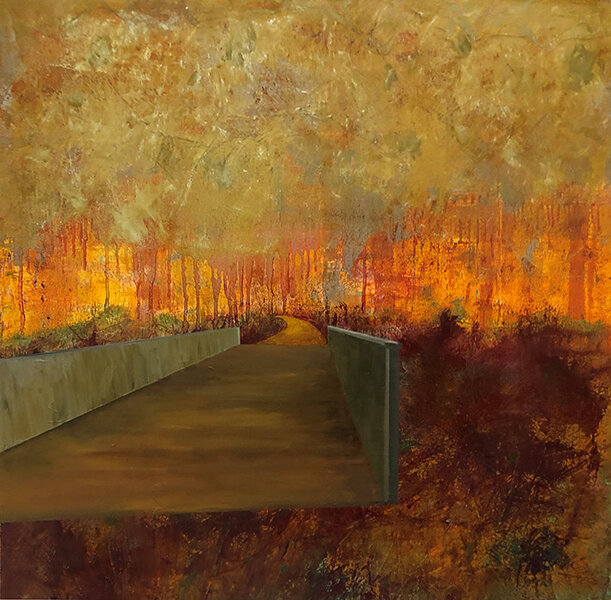The Real and Imaginary Bridges of LA
L.A. Bridges & Artisans
West LA College
9000 Overland Avenue, Culver City, CA 90230
Curated by Molly Barnes and Daniel Citron
November 21 2018 to January 31 2019
While at the West Los Angeles College Gallery I bumped into art dealer and curator Molly Barnes. Her grandfather was a shipbuilder and helped construct the Golden Gate Bridge in San Francisco. “He was famous for putting eyes on the ships he built; he always had a sense of humor,” said Molly. In thinking about her ship and bridge-building relatives, Molly was inspired to organize a show that aims to connect the bridges of Los Angeles to the Los Angeles art world.
Stuart Rapeport
Years ago, I traveled to Toronto from my hometown near Detroit to see the Ontario Museum’s exhibit of Chinese paper making and terracotta sculptures of Chinese soldiers. The stunning installation of about 200 full sized figures floored me. I had a distinct feeling of déjà vu upon entering the West Los Angeles College Gallery to view Los Angeles artist Stuart Rapeport’s wooden sculptures of the L.A. art world’s seasoned veterans and art world aspirants.
The terracotta sculptures were created when Qin Shi Huang, the first Chinese emperor, was 13 years old. The choicest land on Mount Li was selected for the plot: Fine jade deposits were buried there and the northern side was rich in gold. 700,000 workers—or most likely slaves—dug out a section of the mountain and dropped in 8000 terracotta soldiers, along with musicians, acrobats, strongmen and full-sized chariots and horses. Rapeport has dreams of making a thousand similar sculptures representing art world figures (Slaves are hopefully not in the picture; I am giving Rapeport the benefit of the doubt that he will not exploit any workers for his art).
Installation view of List of Art World People +1 by Stuart Rapeport. Image courtesy of the artist and gallery.
Rapeport veers away from the Chinese terracotta soldiers’ erect posture. Each sculpture twists and leans and becomes an animation, but not quite a caricature, of his subject. A mélange of stray pieces of wood come together to create a smile or a tie or an ice cream cone to elicit the essence of his art world subjects. His sculptures have a memorial sensibility: I can imagine their use in a ceremonial context. Perhaps they could serve as a sacrificial pyre to the art gods in front of LA MOCA? Ultimately, the sculptures create an imaginary bridge for Rapaport, and the viewer, to enter the L.A. art world.
David Eddington
David Eddington’s paintings explore L.A.’s architecture through its bridges. The 6th Street Bridge was one of the most iconic bridges in the city, with its majestic art deco arches looking down on the L.A. River. This bridge was actually a viaduct that connected the Arts District in Downtown Los Angeles with the neighborhood of Boyle Heights; artists living downtown would jaunt over this bridge to East L.A. for fresh tortillas. For decades the bridge was used by the film industry as a backdrop or setting for movies and commercials. Unfortunately, of all the majestic bridges built during the 1930’s, this bridge received an inferior batch of highly alkali cement that put it at risk of collapse, thus its recent demolition in 2016.
David Eddington, Demo, 6th Street Bridge, acrylic on canvas, 72 x 66 inches. Image courtesy of the gallery.
Eddington’s choice to paint the 6th Street Bridge was not a premonition of its demise. He loved that bridge and hiked under it, on it, and around it. The people living in storm drains under the bridge knew him, and he felt a kinship with them because they loved the bridge as much as he did. Eddington elevates the bridge to a level of metaphorical importance: water = life, grey = sky, strength = cement; the blending of earth’s natural elements with the man-made bridge captures the flow of life.
Barbara Thomason
L.A. Artist Barbara Thomason exhibits mostly Cel-Vinyl works of L.A. bridges. While I scanned the pieces, I could almost hear Barbara acting as a tour guide saying: “…and here is the Shakespeare Bridge, built in 1926. It is made of concrete and decorated in a Gothic style. It was named after playwright William Shakespeare and eventually became a Los Angeles Historic-Cultural Monument in 1974…”
Barbara Thomason, 6th Street Bridge, Cel-Vinyl, 9 x 14 inches. Image courtesy of the gallery.
Beyond the guided tour, Thomason’s work takes on a nostalgic meaning, and her cinematic eye for bridges is apparent throughout. The story is left up to the viewer: where do these bridges lead? Who will be on the other side? Why did they build this bridge? Of course, some of us can look at these works and be satisfied with the images alone. Perhaps Thomason created the work for just this reason?
Velda Ishizaki
Artist Velda Ishizaki takes the viewer along to the unknown in her bridge paintings. Her use of color steeps us in nature. The paintings tell us to not be afraid, as we are surrounded by beauty. The cold hard cement bridge juxtaposed with the amber colors of fall trees allows the viewer to step into the paintings with a sense of warmness. The floating bridge becomes a metaphor for a connection to the forest of trees and their autumn leaves. A nudge may be all that’s required to get across to our destiny. Her mysterious paintings leave the viewer with a desire to experience all that these bridges have to offer us.
Velda Ishizaki, Ketchum Bridge #2 Idaho, acrylic on canvas, 36 x 36 inches. Image courtesy of the gallery.
The human stories connected to the bridges in our lives are often overlooked. The bridge can easily be regarded as just one way to get from one place to the other. This exhibition brings to focus the way in which bridges bring us not just to other places, but to other people. The bridge becomes a metaphor for our connection to nature, to lovers, to neighbors, to our goals, to the art world, and to other cultures, or like the 6th Street Viaduct used to do for the Downtown Arts District, to some killer tortillas.








